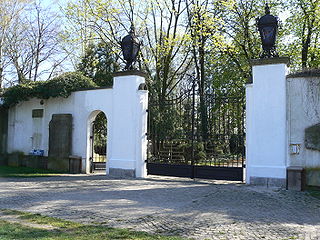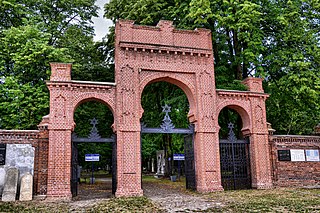
Tombstone is a city in Cochise County, Arizona, United States, founded in 1879 by prospector Ed Schieffelin in what was then Pima County, Arizona Territory. It became one of the last boomtowns in the American frontier. The town grew significantly into the mid-1880s as the local mines produced $40 to $85 million in silver bullion, the largest productive silver district in Arizona. Its population grew from 100 to around 14,000 in less than seven years. It is best known as the site of the Gunfight at the O.K. Corral and draws most of its revenue from tourism.

A gravestone or tombstone is a marker, usually stone, that is placed over a grave. A marker set at the head of the grave may be called a headstone. An especially old or elaborate stone slab may be called a funeral stele, stela, or slab. The use of such markers is traditional for Chinese, Jewish, Christian, and Islamic burials, as well as other traditions. In East Asia, the tomb's spirit tablet is the focus for ancestral veneration and may be removable for greater protection between rituals. Ancient grave markers typically incorporated funerary art, especially details in stone relief. With greater literacy, more markers began to include inscriptions of the deceased's name, date of birth, and date of death, often along with a personal message or prayer. The presence of a frame for photographs of the deceased is also increasingly common.

Boot Hill, or Boothill, is the generic name of many cemeteries, chiefly in the Western United States. During the 19th and early 20th century it was a common name for the burial grounds for paupers.

Tombstone tourist describes an individual who has a passion for and enjoyment of cemeteries, epitaphs, gravestone rubbing, photography, art, and history of (famous) deaths. The term has been most notably used by author and biographer Scott Stanton as the title of his former website and book The Tombstone Tourist: Musicians (2003), about the lives and gravesites of famous musicians.

Laurel Hill Cemetery, also called Laurel Hill East to distinguish it from the affiliated West Laurel Hill Cemetery in Bala Cynwyd, is a historic rural cemetery in the East Falls neighborhood of Philadelphia. Founded in 1836, it was the second major rural cemetery in the United States after Mount Auburn Cemetery in Boston, Massachusetts.

Holyhood Cemetery is a cemetery located in Brookline, Massachusetts.

Hope Cemetery is a rural cemetery in Barre, Vermont. The city calls itself the "Granite Capital of the World", and the cemetery is known for the superb granite craftsmanship on its memorials and tombstones.

Aizy-Jouy is a commune in the department of Aisne in the Hauts-de-France region of northern France.

Avant-lès-Marcilly is a commune in the Aube department in the Grand Est region of north-central France.

The Old Jewish Cemetery of Kraków, more commonly known as the Remah Cemetery, is a historic necropolis established in the years 1535–1551, and one of the oldest existing Jewish cemeteries in Poland. It is situated at 40 Szeroka Street in the Kazimierz district of Kraków, beside the 16th-century Remah Synagogue. The cemetery bears the name of Rabbi Moses Isserles, whose name is abbreviated as Remah.

The First Church of Christ and the Ancient Burying Ground is a historic church and cemetery at 60 Gold Street in Hartford, Connecticut, United States. It is the oldest church congregation in Hartford, founded in 1636 by Thomas Hooker. The present building, the congregation's fourth, was built in 1807, and was listed on the National Register of Historic Places in 1972. The adjacent cemetery, formally set apart in 1640, was the city's sole cemetery until 1803.

Missoula Cemetery is the second oldest cemetery located in Missoula, Montana, with Fort Missoula Cemetery being the oldest. The Missoula Cemetery was first established in 1884 by the Missoula Valley Improvement Company, a corporation owned by prominent citizens Isadore Cohn, Frank Woody, William H.H. Dickinson and Thomas C Marshall. The land where the cemetery would be built was purchased from the Northern Pacific Railroad for $168. The cemetery was eventually sold to the City of Missoula in 1901, for the total of $1.

The Old Jewish Cemetery is a historic necropolis-museum situated on 37/39 Ślężna Street, in the southern part of Wrocław, Poland. Opened in 1856, the cemetery's eclectic layout features many architectural forms and styles on a monumental scale.

The Old Protestant Cemetery, also known as Northam Road Cemetery, is a disused Protestant cemetery in George Town, Penang, Malaysia. After more than a century of neglect, it is now listed as a Class 1 Heritage Site and is maintained by the Penang Heritage Trust.

The New Jewish Cemetery is a historic necropolis situated on 55 Miodowa Street in Kraków, Poland. Located in the former Jewish neighborhood of Kazimierz, it covers an area of about 4.5 hectares. Since 1999, the cemetery is a registered heritage monument. The grounds also feature a well-preserved mortuary.

Boothill Graveyard is a small graveyard of at least 250 interments located in Tombstone, Cochise County, Arizona. Also known as the "Old City Cemetery", the graveyard was used after 1883 only to bury outlaws and a few others. It had a separate Jewish cemetery, which is nearby.

The Tombstones of Ahlat, is the world's largest Turkish-Islamic cemetery in the Middle Ages, located in the Ahlat district of Bitlis in Turkey. The cemetery is an open-air museum today.

The Łódź Jewish Cemetery, also known as the New Jewish Cemetery, was once the largest Jewish cemetery in Poland and one of the largest in the world. Located in the city of Łódź on Bracka Street, the necropolis was opened in 1892 and occupies around 44 hectares of land. The cemetery contains from 180,000 to 230,000 marked graves, as well as mass graves of victims of the Litzmannstadt Ghetto and the Holocaust. From 1893 to 1896, the basic construction of the necropolis was completed under the supervision of well-known architect Adolf Zeligson.

The Jewish Cemetery in Wrzeszcz, a borough of Gdańsk, Pomeranian Voivodeship, Poland, was established in the 18th century. The cemetery on the northern slope of Królewskie Wzgórze on Romualda Traugutta Street is now a publicly accessible park. It is not a protected heritage site.

The Jewish cemetery in Oświęcim, Poland, was destroyed by the Germans during World War II and partly restored by returning Jewish survivors after the Holocaust. In Communist Poland it fell into disrepair and was fully restored in the 1990s.




















